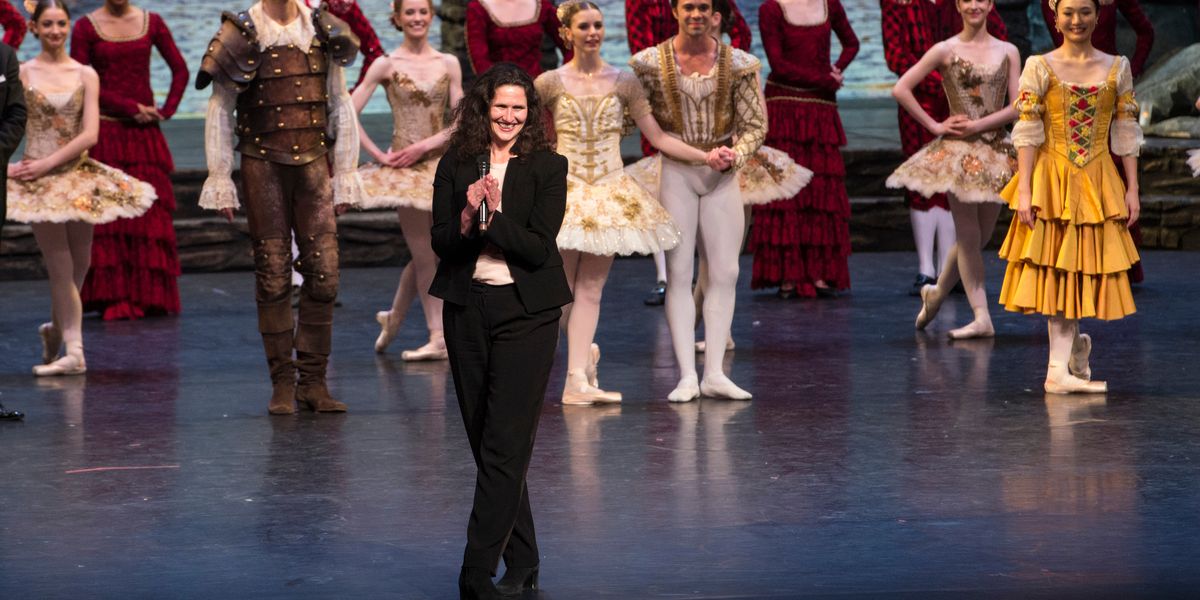From Dancer to Director: Norwegian National Ballet's Ingrid Lorentzen
One of the first things you notice about Ingrid Lorentzen is her laugh—the Norwegian National Ballet director exudes warmth. It’s obvious why, in 2012, she was appointed for the job, despite the fact that she was a leading dancer at NNB with little management experience. But Lorentzen knew it wouldn’t all be smooth sailing. “I started my first speech by telling the company: ‘I’m going to disappoint you all,’ ” she remembers with a chuckle.
That lucidity, along with her open-minded philosophy, has contributed to lifting the profile of Norway’s national company, founded in 1958. As director, Lorentzen has challenged her 65 dancers with boundary-pushing new productions, from Alexander Ekman’s water-filled A Swan Lake to ballets based on Scandinavian plays. Programmers have taken notice: This creative vibe and NNB’s close relationship with Jirˇří Kylián have led to a series of international engagements.
 Kylián’s “Falling Angels.” Photo by Erik Berg, Courtesy NNB.
Kylián’s “Falling Angels.” Photo by Erik Berg, Courtesy NNB.
Lorentzen has drawn diverse talent, from Cuban stars Yolanda Correa and Osiel Gouneo to American standouts like Melissa Hough and Whitney Jensen. “When I first spoke to Ingrid, I was astonished at how personable she was,” says Hough.
The 45-year-old director was a maverick from a young age. Born in a small Norwegian town, she didn’t go into pre-professional training until the age of 16. Less than a year later, she told the director of Oslo’s National Academy of the Arts that the classical training wasn’t strong enough—and moved to the Royal Swedish Ballet School.
After an apprenticeship with the Norwegian National Ballet, Lorentzen went freelance, performing in theater projects and ultimately joining a Swedish contemporary company, Skånes Dansteater. “It shaped my philosophy: I want dancers who can stand out but be part of a collective,” says Lorentzen.
Later, she auditioned for NNB four times before she was hired. “They weren’t sure about my height, my age.” But in three years, she was promoted to the top rank, soloist.
When company director Espen Giljane left in 2012, the general director of the Norwegian Opera urged Lorentzen to apply. By then, she’d taken a seat on the Arts Council Norway, which implements cultural policy. “I said no originally,” she remembers. The search committee insisted, and Lorentzen’s status as a former-outsider-turned-team-player worked in her favor. “I’ve seen the company from the inside, but also from the other side, having danced in other theaters.”
 Ingrid Lorentzen. Photo by Erik Berg, Courtesy NNB.
Ingrid Lorentzen. Photo by Erik Berg, Courtesy NNB.
Lorentzen accepted, hung up her pointe shoes and set out to find a balance between three pillars in the repertoire: the classics, especially traditional full-lengths; international masters, like Kylián; and creations.
As she had warned her company, there were bumps in the road. Her first program in 2013 was five world premieres inspired by Michel Fokine. “It was a huge success,” says Lorentzen, “but that’s the moment the dancers said, ‘We have no confidence in you.’ ” The boundary-pushing program fazed them. “They weren’t happy.”
Lorentzen’s response was more communication. “In Norway, you have to get the company with you, because you can’t fire anyone,” she explains. Social protection is very high: Dancers are on permanent contracts, and retire with a pension at 41. Benefits such as maternity leave are generous. “Here I began thinking about my life as a whole, not just as my dancer self,” says Hough, who previously danced with Boston Ballet and Houston Ballet.
To balance out that security, Lorentzen believes in a degree of artistic insecurity. There are only two ranks, corps and soloist, and all dancers have to audition for parts.
 Norwegian National Ballet’s “Nutcracker.” Photo by Erik Berg, Courtesy NNB.
Norwegian National Ballet’s “Nutcracker.” Photo by Erik Berg, Courtesy NNB.
New evening-length narrative ballets, a particular focus for Lorentzen, have ranged from Liam Scarlett’s Carmen to an adaptation of Henrik Ibsen’s play Hedda Gabler by theater director Marit Moum Aune, premiering September 28.
Lorentzen has also commissioned company dancers, including Hough, who was part of Sleepless Beauty, an evening of creations by women. Last season, 8 out of the 17 choreographers featured were female. “The lack of balance is so depressing,” Lorentzen says. “I thought, Let’s stop talking, let’s just do.”
With stable government funding and a new opera house, opened in 2008, the future is bright. In 2015, Lorentzen launched the Norwegian National Ballet 2, which also affords its dancers full salaries. More than a third of the main company members hail from Norway, and Lorentzen is building closer ties with the affiliated National Academy.
Now with the full confidence of her company, her contract has been extended through 2022. Hough pays tribute to Lorentzen’s positive management style. “Ingrid has taught me I can be honest without fear,” she says. “I have learned to own who I am as an artist and person.”
 Ibsen’s “Ghost.” Photo by Erik Berg, Courtesy NNB.
Ibsen’s “Ghost.” Photo by Erik Berg, Courtesy NNB.
At a Glance
Norwegian National Ballet
Number of dancers: 65
Length of contract: Year-round, permanent
Starting salary: Around $56,000 ($49,000 for NNB2)
Performances per year: Around 100
Website: operaen.no/en
Audition Advice
Open auditions are currently only held for Norwegian National Ballet 2. In addition to one in Norway every year, Lorentzen takes part in the Grand Audition, the multi-company audition held in Barcelona (the next one is scheduled for February 6–7, 2018). “I like athletic classical dancers, with very strong footwork and articulation,” she says. “But it’s also about the feeling I get from them, who I think can adapt to the Norwegian way.” She’ll occasionally invite applicants for the main company to take class.





